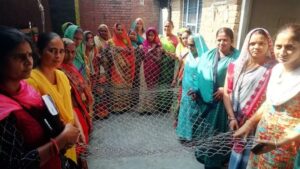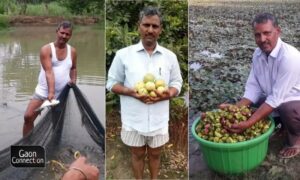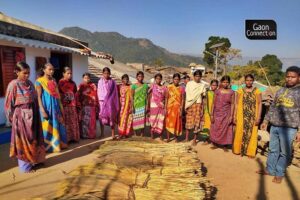Srinagar, J&K
Adil Ahmad is an assistant director of the fisheries department in the southern state of Karnataka. Recently, he travelled 3,000 kilometres to the north of India, to visit Asia’s largest trout farm — the eight-hectare Kokernag fisheries farm in Jammu and Kashmir. Reason: To learn how rainbow trout, a highly profitable fish that can grow up to three kilogrammes (kg) in weight and which sells at Rs 500 a kg, is cultivated.
Rainbow trout is rich in protein and is said to boost immunity, another reason for its popularity. Trout farmers create artificial ponds on land to raise the fish.
“We were given training about breeding and feeding of trout. We are making efforts to introduce trout in Karnataka,” Ahmad told Gaon Connection.
Besides such training, since the beginning of the year, the department of fisheries in Jammu and Kashmir has sent out several lakh eyed ova (developing eggs, each costing Rs two) of the much-prized rainbow trout, from Kokernag, about 80 kilometres from Srinagar. Rainbow trouts are predominantly blue, green, yellow and silver in colour, and glisten in various shades of the rainbow. Hence, the name.
Promoting trout farming in states
Recently, about 700,000 eyed ova have been sent to states such as Nagaland, Arunachal Pradesh, Uttarakhand and Sikkim. Earlier, they were also sent to Meghalaya and Himachal Pradesh and neighbouring Nepal. Lakhs of eyed ova have been distributed among local fish farms in the union territory, at a subsidy. Local fish farmers have been trained free of cost, Muzaffar Bazaaz, fisheries expert and chief project officer of the Kokernag farm, told Gaon Connection.
Trout farming is an important source of income for farmers in the Kashmir region. Trout need running water and temperatures ranging between 0 and 20 degree Celsius to thrive.
According to fisheries department figures, government and private farms produce 600 tonnes of trout annually in Kashmir, generating a revenue of more than Rs 13 crore (Rs 130 million). There are 581 private trout fish units in Kashmir and 200 more are being established in next few months under the Pradhan Mantri Matsya Sampada Yojana, a scheme to boost fish production and generate employment opportunities.
“Various state governments purchase ova from us and supply it to their farmers who rear it in farms. The success rate is good, and this has inspired many states to take it up,” Bazaaz said.
Trout story: from Scotland to Srinagar
More than a century ago, when it all began in December 1900, no one would have expected trout farming to get popular in the Valley. It is said the first consignment of 10,000 trout eggs came from Britain in 1899, but perished mid-way due to the long journey. The next year, they got lucky. A shipment of trout ova, including 1,800 fry, came in from Scotland on December 19, 1900, and reached in good shape.
These were split between one Mister Michel, who owned a private carpet factory in Baghi Dilawar Khan, and Panzagam Dachigam (Harwan) (Dachigam National Park), about 24 km from Srinagar, says the website of the J&K fisheries department.
And thus, trout farming made a humble beginning in the Valley.
Farmer Shakeel Mohammad Teli, 55, from Sakhras Srigufwara in South Kashmir’s Anantnag district established a fish farm in 2009 along with his brother and nephew on 30 marla (0.075 hectare) of land. The three of them get a share of over Rs 300,000 annually. Teli’s nephew, who is a post-graduate in commerce, has taken up trout farming; his daughter, a post-graduate who also has a bachelor’s degree in education is to run a trout farm too, instead of looking for a government job.
Good return on investment
What has triggered this interest in trout farming? The profits and the fact that trout grows well in cold regions.
Ova are spawned from high quality fish and placed in hatchery jars. It takes 12-15 months for the trout to grow over 250 grams. These are then ready for sale to trout farms, where they grow up to three kg before being sold in the market.
Last year, despite the COVID-19 pandemic, Teli and his partners sold 1,400 kilogrammes of trout for Rs 700,000 — they made a profit of Rs 600,000 on an investment of Rs 100,000. “Rearing trout gives us better returns than crops we could have cultivated on this land. This sector has huge potential, and if one works with dedication, one can even trout provide employment to others,” Teli said.
Bashir Ahmad, 36, another farmer from Kokernag, said his father established the family’s trout farm in 2013 by constructing three reservoirs on 15 marla (0.037 hectare) of land. “We annually earn between five lakh and five-and-a-half lakh rupees from trout farming. I did not apply for a government job, and began helping my father. Those who have land and access to running water should start trout farming instead of cultivating other crops,” he told Gaon Connection.
Ahmad looks after his parents, wife, younger sister and two daughters. “After completing my graduation, I worked as a salesperson, but it was difficult to make good money. For the past seven years, I am able to fulfil all necessities at home,” he added.
Trout district of India
In Anantnag district, a lot of fish farms have been established with government support. In June 2018, Anantnag district was also declared as ‘Trout district of India’. Shabir Ahmad Bhat, assistant director in the fisheries department, Anantnag, said there were 137 private fish farms just in Anantnag district. “This sector has huge potential and trout farming is also being introduced in other parts of India,” he said.
Other than farms, trout is naturally found in the streams and nallahs of the valley, in places such as Lidder, Wangath, Gurez, Hamal, Lam and Bringi.
The Kokernag fisheries farm, set up in 1985 with support from the European Economic Committee, is supervised by Manzoor Ahmad. “We have to be careful while rearing trout. Unlike other species, trout need fresh running water and need to be fed on time,” he said.
In a land of one kanal area (0.050 hectare), four fish ponds can be set up at a cost of around Rs 700,000. The union territory provides a 40 per cent subsidy for every pond set up on a trout farm.
Anayitullah Chesti, a professor with the fisheries department of Sher-e-Kashmir University of Agricultural Sciences & Technology of Kashmir said fish culture has tremendous scope across the world. “The trout introduced in Kashmir is a cold water fish. It can be reared anywhere in the world provided the optimum temperature and running water needs are met. Trout has a good success rate in and outside India,” he told Gaon Connection.
Brown trout can be found in rivers. However, rainbow trout raised in open water sources face threats, Bazaaz of the Kokernag farm, said. “The breeding of the rainbow trout is disturbed due to unabated mineral extraction and other activities. That is why we rear the rainbow trout in ponds, with a defined entry and exit of running water. It grows fast and is also resistant to disease. If the temperature remains between tweleve and eighteen degrees Celsius for a year, a trout can grow up to three kilogrammes in a year,” he added.
Bashir Ahmad Bhat, director of the fisheries department in J&K, said there were various schemes for farmers who want to start fish farms. “The government provides all possible support to those who are associated with this sector. We have no shortage of ova here,” he told Gaon Connection.



















